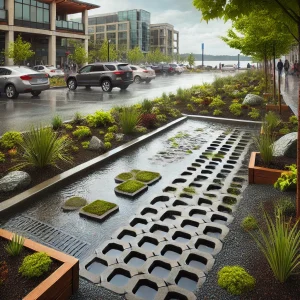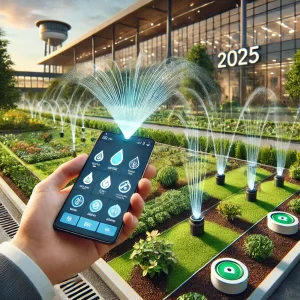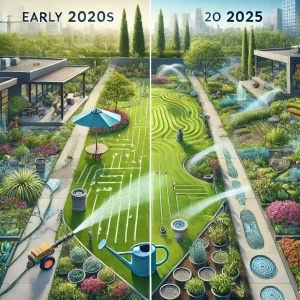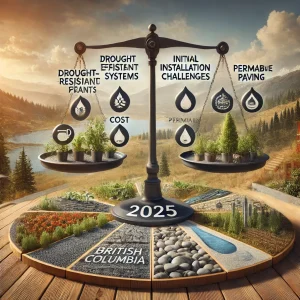As we move further into 2025, the landscaping industry witnesses a profound shift toward climate-resilient designs and eco-friendly solutions. With climate change becoming an increasingly pressing concern, the integration of sustainable practices in landscaping has never been more critical. This blog explores the latest innovations in the field, focusing on how these trends are reshaping both residential and commercial landscapes, particularly in British Columbia.
Drought-Resistant Plants: A New Norm
One of the most significant trends in 2025 is the widespread adoption of drought-resistant plants. As water scarcity becomes a more pressing issue globally, these plants are not only a necessity but also a hallmark of sustainable landscaping. Landscapers extensively use drought-resistant plants such as lavender, succulents, and ornamental grasses in both residential gardens and commercial spaces.
In British Columbia, for instance, landscapers increasingly use native drought-resistant species like the Garry oak and Pacific madrone. These plants, adapted to the local climate, require minimal watering, making them ideal for sustainable landscaping. Compared to previous years, when lush, water-intensive lawns dominated, 2025 marks a significant shift towards xeriscaping—a landscaping style that reduces or eliminates the need for irrigation.

Permeable Paving: Managing Water Runoff Effectively
Another innovation gaining traction in 2025 is permeable paving. Traditional paving methods often lead to water runoff, which can cause flooding and erosion, particularly in urban areas. Permeable paving, on the other hand, allows water to seep through the surface and into the ground, reducing runoff and replenishing groundwater supplies.
In Victoria, British Columbia, both residential driveways and commercial parking lots increasingly integrate permeable paving solutions. These solutions mitigate the impact of heavy rainfall and contribute to the overall health of the local ecosystem. The adoption of permeable paving has significantly increased compared to previous years, driven by growing awareness of its environmental benefits and the need for sustainable urban infrastructure.

Water-Efficient Irrigation Systems: Precision in Watering
Water-efficient irrigation systems have dramatically evolved in 2025, with smart technology playing a crucial role. These systems use sensors to monitor soil moisture levels and weather conditions, adjusting watering schedules automatically to ensure optimal hydration without wasting water.
In British Columbia’s commercial landscapes, landscapers use these systems to maintain large green spaces with minimal water usage. For residential gardens, smart irrigation controllers are becoming increasingly popular, allowing homeowners to manage their watering schedules remotely via smartphone apps. This shift towards water-efficient irrigation marks a departure from traditional sprinkler systems, which often led to overwatering and wasted resources.

Comparing 2025 Innovations to Previous Trends
The landscaping industry in 2025 shows a clear progression from the trends of previous years. In the early 2020s, sustainability was a growing concern, but the focus was often on aesthetic appeal rather than environmental impact. Lawns were still the norm, and water consumption was rarely questioned. However, as the effects of climate change have become more evident, the industry has shifted towards practices that prioritize resilience and sustainability.
For example, while drought-resistant plants were available in previous years, their adoption remained limited. In contrast, 2025 sees these plants becoming a standard feature in landscaping projects, driven by the need to conserve water. Similarly, permeable paving was once considered a niche solution, but it is now widely recognized as an essential component of sustainable urban design. Water-efficient irrigation systems have also evolved from basic timers to sophisticated, sensor-driven technologies that optimize water use in real-time.

Benefits, Challenges, and ROI
The benefits of these innovations are clear: they contribute to the conservation of natural resources, reduce environmental impact, and help landscapes thrive even in challenging climates. However, challenges still exist. The initial cost of installing permeable paving or smart irrigation systems can be higher than traditional methods. Additionally, the transition to drought-resistant plants may require a shift in aesthetic preferences, particularly for those accustomed to lush green lawns.
Despite these challenges, the return on investment (ROI) for these innovations is promising. Drought-resistant plants and water-efficient irrigation systems can significantly reduce water bills, while permeable paving can lower the cost of stormwater management and prevent costly flood damage. Moreover, as these practices become more widespread, the cost of implementation is likely to decrease, making them more accessible to a broader audience.
The landscaping industry in 2025 stands at the forefront of the fight against climate change, with innovations that emphasize sustainability and resilience. By integrating drought-resistant plants, permeable paving, and water-efficient irrigation systems, both residential and commercial landscapes can adapt to the challenges posed by a changing climate. As these trends continue to evolve, they offer a glimpse into the future of landscaping—one where beauty and sustainability go hand in hand.
British Columbia, with its diverse climate and commitment to environmental stewardship, leads the way in adopting these innovations, setting a standard for the rest of the world to follow.
